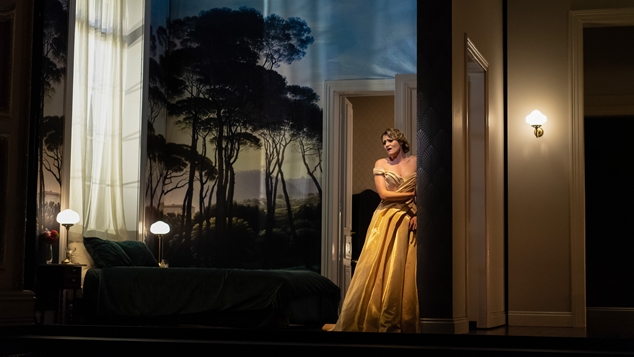
La Traviata | His Majesty’s Theatre | til 29 Oct | ★ ★ ★ ★ ½
How can a story about a 19th Century French prostitute be relevant to today’s Australian audiences? This production of Giuseppe Verdi’s La Traviata is a joint venture between Opera Queensland, State Opera of South Australia and West Australian Opera that re-imagines the tale of love, lust, and sacrifice. Despite the poor reception received when it premiered in Venice in 1853, La Traviata is one of Verdi’s most popular operas today. At the time it was shocking to see risqué themes like a woman portrayed as an independent and openly sexual person, yet still holds so much relevance today.
La Traviata is usually seen through the lens of a male third party. Prompted by the lack of Violetta’s perspective in many La Traviata productions, Director Sarah Giles studied the diaries of a Parisian courtesan of a similar era to facilitate this feminist driven interpretation. Women of the era often had the choice between abuse and poverty or selling their bodies for money. Once a woman had registered with the local police to ‘sell her body’ you could never have your name removed. However, the men who visited these brothels were able to come and go whilst maintaining their personal reputation. The double standards of those times feel sadly familiar, and Giles’ production highlights the lack of female autonomy and gender politics still in our society today.
Award winning costume and set designer Charles Davis created the majority of the vision whilst in lockdown and said that spending so much time working in solitude, gave him the compassion for the experiences of protagonist Violetta. The curtain lifts as the overture began and we’re suddenly drenched in the rich colour palette of Violetta’s world. The compartmentalised layout and architecture of the set allows for concurrent views into both Violetta’s public and private life. As the curtain lifts, we see Violetta in her grand, luxurious home, draped over her bed while a grand party is happening in the room next door. It all looks like a relatively standard opening scene until we see a man crawl out from beneath her bedsheets, just as a maid arrives to help her prepare for the party she’s throwing that’s already started. The costumes and set, whilst presenting in a period setting seeming to be drawn the late 19th Century (corseted bodices and layered petticoats) also gives a nod to more recent fashion with use of contemporary fabric selection and detailing.
The sets and costume were a work of art in themselves, however Giles’ stage direction heightened the excitement and drama, especially in their first chorus number Libiamo ne’ lieti calici. When any of the characters were singing, the entire chorus froze, creating several tableaux moments. The chorus was well rehearsed, despite feeling like they were overcrowding the space at times, the ensemble gave brilliant support to the character roles and did a fantastic job of setting the scenes. The set soon transformed to take us to the country house where Violetta and Alfredo were living, looking out to a garden.
As the curtain lifts for the final act, we see excited, drunken party goers running around half dressed, hair a mess, most of them are sporting some colourful pash rash and I even saw two ladies motorboating each other! The cheers and frivolity are contagious throughout the party and I think Giles can be confident that her goal of presenting the work through a feminist eye, highlighting the lack of change for women today was well and truly realised.
Ending with Violetta’s death, the closing scene took a different direction to any La Traviata production I’ve seen before. This simple, bare staging left room on the stage for nothing but visceral devastation – keep the tissues handy.
Under the baton of Christopher Van Tiunen, the WA Symphony Orchestra carried the story through Verdi’s score with absolute gusto. Singing the role of Violetta was Perth’s very own Samantha Clarke. In an interview with Ellie Caruso, Clarke mentions “I feel it speaks to lots of people and the forbidden relationship speaks to so many various facets of life; tradition that may forbid a relationship, or class.”
So often opera stars have a brilliant instrument but lack the acting chops to match. Not only was Clarke’s singing superb, but her acting was sublime; her depth of understanding of this fully realised character was so apparent. I felt privileged to witness Clarke’s debut in the role, and I kept thinking throughout the performance ‘if this is her first Violetta, I cant imagine what her Violetta will be like in ten years’ time!’. Despite the mountainous role she played, Clarke made it look easy, maintaining her well controlled, rich yet light, luscious tone throughout the entirety of her performance.
Singing the role of Alfredo was tenor Paul O’Neill. I don’t think I’ve seen a WA Opera production that didn’t star Paul O’Neill, and as always, he gave a nuanced and beautiful performance. His chemistry with Clarke was stunning; as if they’ve been working on this together for years, their duets were breathtaking and O’Neill’s bright tone filled the theatre in his heart-wrenching performance.
I thoroughly enjoyed the singing of Simon Meadows in the role of Giorgio Germont, his baritone voice was so rich and powerful; however found his acting to be lacking commitment and character to match the voice. In the role of Baron Douphol, Mark Alderson played his role with grandiose authority. Fiona Campbell sung the role of Flora, her exuberant characterisation contrasted so beautifully with Violetta’s despair.
The combination of incredible singing, thoughtful direction, lavish costume and set design and expert accompaniment brings this work together in a spectacular night out at the opera.
Claira Prider
Image: Clinton Bradbury
You can support our work by subscribing to our Patreon
or contributing to our GoFundMe campaign.





